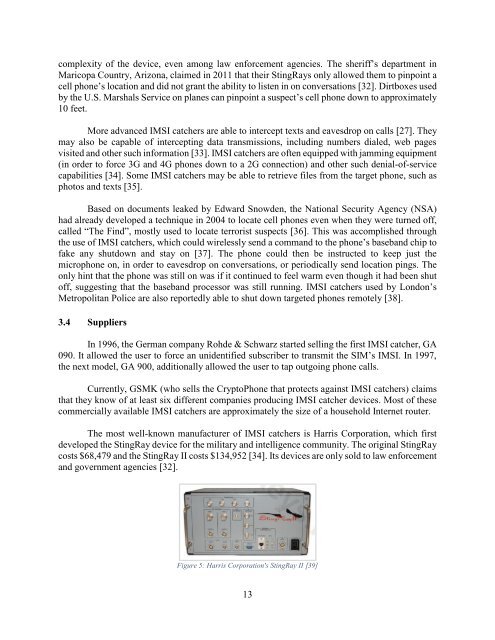IMSI Catchers and Mobile Security
EAS499Honors-IMSICatchersandMobileSecurity-V18F-1
EAS499Honors-IMSICatchersandMobileSecurity-V18F-1
Create successful ePaper yourself
Turn your PDF publications into a flip-book with our unique Google optimized e-Paper software.
complexity of the device, even among law enforcement agencies. The sheriff’s department in<br />
Maricopa Country, Arizona, claimed in 2011 that their StingRays only allowed them to pinpoint a<br />
cell phone’s location <strong>and</strong> did not grant the ability to listen in on conversations [32]. Dirtboxes used<br />
by the U.S. Marshals Service on planes can pinpoint a suspect’s cell phone down to approximately<br />
10 feet.<br />
More advanced <strong>IMSI</strong> catchers are able to intercept texts <strong>and</strong> eavesdrop on calls [27]. They<br />
may also be capable of intercepting data transmissions, including numbers dialed, web pages<br />
visited <strong>and</strong> other such information [33]. <strong>IMSI</strong> catchers are often equipped with jamming equipment<br />
(in order to force 3G <strong>and</strong> 4G phones down to a 2G connection) <strong>and</strong> other such denial-of-service<br />
capabilities [34]. Some <strong>IMSI</strong> catchers may be able to retrieve files from the target phone, such as<br />
photos <strong>and</strong> texts [35].<br />
Based on documents leaked by Edward Snowden, the National <strong>Security</strong> Agency (NSA)<br />
had already developed a technique in 2004 to locate cell phones even when they were turned off,<br />
called “The Find”, mostly used to locate terrorist suspects [36]. This was accomplished through<br />
the use of <strong>IMSI</strong> catchers, which could wirelessly send a comm<strong>and</strong> to the phone’s baseb<strong>and</strong> chip to<br />
fake any shutdown <strong>and</strong> stay on [37]. The phone could then be instructed to keep just the<br />
microphone on, in order to eavesdrop on conversations, or periodically send location pings. The<br />
only hint that the phone was still on was if it continued to feel warm even though it had been shut<br />
off, suggesting that the baseb<strong>and</strong> processor was still running. <strong>IMSI</strong> catchers used by London’s<br />
Metropolitan Police are also reportedly able to shut down targeted phones remotely [38].<br />
3.4 Suppliers<br />
In 1996, the German company Rohde & Schwarz started selling the first <strong>IMSI</strong> catcher, GA<br />
090. It allowed the user to force an unidentified subscriber to transmit the SIM’s <strong>IMSI</strong>. In 1997,<br />
the next model, GA 900, additionally allowed the user to tap outgoing phone calls.<br />
Currently, GSMK (who sells the CryptoPhone that protects against <strong>IMSI</strong> catchers) claims<br />
that they know of at least six different companies producing <strong>IMSI</strong> catcher devices. Most of these<br />
commercially available <strong>IMSI</strong> catchers are approximately the size of a household Internet router.<br />
The most well-known manufacturer of <strong>IMSI</strong> catchers is Harris Corporation, which first<br />
developed the StingRay device for the military <strong>and</strong> intelligence community. The original StingRay<br />
costs $68,479 <strong>and</strong> the StingRay II costs $134,952 [34]. Its devices are only sold to law enforcement<br />
<strong>and</strong> government agencies [32].<br />
Figure 5: Harris Corporation's StingRay II [39]<br />
13



